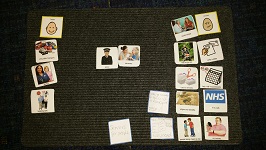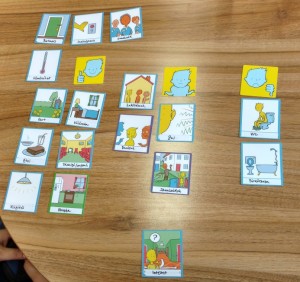Thanks to Agnes Turnpenny for her guest blog on her research on views of people moving form institutional care in Hungary.
There are approximately 15 thousand adults and children with learning disabilities living in large institutions in Hungary. The average size of these facilities is over 100 places, and living conditions as well as the quality of care are often very poor. The Hungarian Government adopted a strategy in 2010 to close and replace these institutions with smaller scale housing in the community. Between 2012 and 2016 six institutions closed and more than 600 people moved to new accommodation. The Mental Health Initiative of the Open Society Institute and the Hungarian Civil Liberties Union commissioned a study to analyse the experiences of the deinstitutionalisation process and as part of this research we carried out some interviews to explore the views of people moving out of the institutions.
The participants – five men and four women – came from one institution in the North East of Hungary, they all had mild learning disability and some had additional mental health issues. Originally the study intended to explore the experience of moving out but due to delays in the project this was not possible. Instead, we decided to examine the expectations of moving from an institution to a smaller home that allows more independence and personalised support. Although only one of the participants had communication difficulties – thus conventional interview methods could have been utilised – I decided to use Talking Mats in order to help participants to contrast their current situation with expectations about the future.
I selected the ‘Where you live’ topic from the Social Care package with some additional images from the ‘Leisure and Environment’ and ‘Relationship’ topics. (The English labels were covered over with a Hungarian translation as most of the participants could read). The question I asked was “How do you feel about these aspects in the institution?” and “What do you think they will be like in the new home?”. (I forgot to take a mat with us, therefore we had to lay out cards on the table.)
It emerged – unsurprisingly – from the interviews that most participants anticipated the improvement of their living conditions from the move, especially better facilities (mainly bathroom and kitchen). Some also expected other positive changes, particularly less conflict with other residents, less noise and better safety –commenting on the prevalence of theft in the institution. There were also many uncertainties; people said they were unsure about how they would get on with their new housemates, how the new support arrangements with staff would work, whether the neighbours will be welcoming etc. The photos illustrate some these issues.
Overall, Talking Mats proved to be a very useful tool in interviewing participants, who really engaged with the method. The images and the completed mats encouraged further comments and explanations on issues that participants considered important with minimum prompting. The drawings were easily recognised and appropriate in the Hungarian context without any adaptations other than the labels. Finally, I felt that the use of Talking Mats in this particular situation helped to overcome some of the power imbalance between the researcher and the participants by giving them more control when handing over the images.
We are really grateful to Agnes Turnpenny from The Tizard Centre University of Kent for sharing her experience . We really value our European work and European connections.
Talking Mats considers both health and social aspects when it is used to include people in their care planning. Lots of interesting comments are made by course participants on the forum in our online training course. Annemarie, who works as an agency carer visiting clients in their own homes posted her thoughts about the social model of disability
Remembering the person behind the condition
In my experience, society is fixated on the medical model, the ‘what’s wrong’ approach. Whilst the medical model is clearly a valuable and required tool, it often leads to labels that individuals are then lumbered with, such as, ‘she has dementia’, ‘she is visually impaired’, ‘he’s deaf’ or has a ‘leaning disability’. Taking this approach overlooks the person behind the ‘condition’ and so can restrict inclusion. One example could be an individual with dementia being unable to make everyday choices about seemingly mundane issues such as what to wear that day. Using a medical model, a carer may be aware of the clients difficulties and make choices for them, whereas using the social model approach enables the carer to see beyond the condition and fully include the client, allowing them to be part of the decision making process for themselves. A second example could be a person with a communication disorder such as Asperger’s Syndrome. Access to work could be severely restricted using a medical model as the pragmatic manifestation of this condition may well exclude a person from seeking certain types of employment. Promoting the use of a social model would ensure work colleagues understood the possible limitations of the condition and ensure adequate support networks were in place. The social model attempts to embrace a person’s difference and raises awareness within society of individual needs that will facilitate inclusion into all aspects of life.
The WHO ICF -World Health Organisation International Classification Framework of Functioning, Disability and Health (2001, 2007b) aims to merge the medical and social model, encouraging professionals to think not only of the persons health condition and resulting impairment, but the impact this has on the persons participation and activities. It captures the full complexity of people’s lives, including environmental and social factors and can be applied over different cultures
The Talking Mats Health and Well- being resource is based on the WHO ICF and supports a person to reflect and express their view on various aspects of their lives. Using the Health and Well being resource supports workers to remember the person behind the condition.
The Scottish Government has granted further funding for the Keeping Safe Talking Mats training and resources.
This extension coincides with the launch of the Keeping Safe report 2013-2016 at a seminar on Thursday 19th May at the Raploch Community Centre Stirling. It’s great to hold our event during Learning Disability week where the theme is Celebrating Success. This project has undoubtedly been a success. 234 Keeping Safe communication resources are in use across Scotland. Staff who have used the Keeping Safe resource report that it supports Safeguarding and helps people think how their life is going, enabling them to express concerns they might have, either big or small. The impact that the resource has on the lives of people with learning disability is powerful. You can read more about this in our previous blog or in the Keeping Safe report 2013-2016
The seminar on the 19th of May is an opportunity to share experiences and explore further some of the issues that exist for people with learning disabilities.
The next tranche of funding provides more training courses for:
- People who work with adults with learning disabilities in Scotland to learn the skills and use the resource to support listening to their service users and
- The staff who use the resource regularly to become Keeping Safe trainers and support the aim of ensuring adults with a learning disability in Scotland have access to this communication tool. We particularly want to target geographical areas that do not yet have Keeping Safe trainers, e.g. Dumfries and Galloway and Aberdeenshire.
If you work with adults with learning disabilities in Scotland and would like to apply for Keeping Safe training please contact the office info@talkingmats.com Application for
Striling course 19th August and 16th September is here; 20160610 training flier
Aberdeen Course 9th September and 7th of October is here 20160909 Aberdeen flier
Dumfries and Galloway course 20th October and 25th November is here 20161027 training flier
Further courses are being planned in the Autumn in Dumfries and Central Belt .Please contact Info@talkingmats.com if you wish to be sent the relevant flyer
It is important that we ask people with learning disability about their lives and enable them to raise any concerns. Over the past couple of years we have been developing a Talking Mat called Keeping Safe. It is a resource that gives people time to think about various aspects of their lives, and express how it is going for them.
234 staff in different parts of Scotland now have the resource and have been trained to use it. Feedback includes that using the Keeping Safe resource can improve the quality of communication for both the person with a learning disability and the staff member in the following ways :
- Staff frequently commented that using the Mats revealed things they had not known previously;
‘It gave so much information which we did not expect. It will assist in Adult Support and Protection feedback. It gave him his own say in things.’
‘allowed needs to be identified that I would not have thought to ask about, such as the smoking and taking drugs.’
- It enabled staff have a conversation about more sensitive and or difficult issues;
‘Usually when she expresses her feelings she can get either upset or angry. She did not get upset or angry at any point through doing the Talking Mats, although the subject and things she was saying was at times difficult issues.’
‘A has good communication skills but as we had a sensitive issue (personal care) to discuss I felt that a talking mat would allow us to explore this.’
- It also helped the thinker ( the thinker is the person doing the mat ) to express their thoughts clearly
‘allowed this person to disclose things that they were struggling to disclose verbally.’
- It helped with memory difficulties and kept the thinker focused on the topic
‘It helps with memory and attention as she has something visual to keep her focused.’
- The information gained reflected the thinker’s view and not the views of those around them
‘This resource gave this gentleman the power to say exactly what he was thinking and not what he thought someone wanted to hear.’
- There was a lot of positive feedback on using the resource from people with learning disabilities
‘I adore this. The mats really helped me speak about my feelings.’
- It was a quick way to get information. Initially many staff thought using the resource would take too much time but in fact were surprised to find how much information they got in a short space of time.
The stories gathered from using the resource are powerful and a final report is being prepared which will be launched at a seminar on the 19th May during learning disability week . There are still some spaces on the seminar so if you would like to attend please contact info@talkingmats.com .
We are delighted that the Scottish Government is funding a further round of Keeping Safe Talking Mats training. If you work with adults with learning disability in Scotland, and would like to apply to a Keeping Safe Talking Mats training course then please email us for dates and the application form.
Thanks to Alison Matthews for a great guest blog on Talking Mats supporting people with learning disability to have a political voice In the photo from left to right Alison Matthews, John Hendrickson ( chair of NW LDA) , Shahnaz Ashraf, Rosemary Trustam, Darren Heywood (vice chair)
The North West Learning Disability Alliance (LDA) is a campaign group focussing on the rights of people with learning disabilities. The NW regional self -advocates forum met twice to identify their priority concerns which were due to be discussed at the regional conference in Blackpool. Members of the NW LDA attended a conference planning event and we discussed ways in which people could be supported to voice their views on services. It was agreed that given the need for local and national politicians representing their citizens to hear the views of people with learning disabilities, the conference would be a way to develop this with the help of social media. The NW LDA was then invited to have a stand at the conference in Blackpool.
Talking Mats seemed the obvious approach to support discussions around the concerns as it provided a structured means of people expressing their views and provided potential objectivity in that people could also praise services, as well as voice concerns, which in fact some did! We wanted to take photographs of people with their mats as we felt it would bring the concerns or issues to life, it certainly seemed a more powerful way of enabling people to speak out. Our idea then was to e mail relevant local councillor or MP and to support people to get their voices heard wherever possible.
Some of the challenge was in planning the vocabulary needed and in finding the appropriate visual scale. The list of concerns created by the self- advocates provided an ideal starting point. The scale we opted for consisted of symbols which enabled people to say whether they were worried about the topic or happy/not concerned. The topic itself was ‘services’. Finding symbols was a real challenge so we opted for a mixture in the end, photos, symbols, photosymbols and our own line drawings.
We spent time with the self -advocates who produced a mat, first exploring their knowledge of social media, in particular Twitter and Facebook. Many already had accounts and e mail addresses, some people came ready with topics they wanted to get off their chests or people they wanted to praise. Everyone said whether or not they wanted to e mail their MP or local councillor with a photo of them and their mat and whether they wanted us to post the photograph of them with a mat on social media. For Twitter we used the hashtag our voices matter (#ourvoicesmatter).

People raised concerns about a variety of issues to do with service cuts, from cuts to the NHS and the need for local pharmacies to stay open, to cuts to transport and the need for additional support with relationships. One person mentioned specifically that she wanted to feel safe at home and talked about crime directed towards people with learning disabilities. Most people were worried about benefit cuts
We had some positive responses, one person wanted to highlight how happy she feels in her new flat and one person specifically wanted to compliment his local councillor who he felt really listened to people with learning disabilities. Ivan Lewis MP tweeted his support for the campaign. In terms of learning for next year’s conference, we will develop the vocabulary and the process of collecting e mail addresses and twitter accounts for MP’s. One very valuable lesson we learned about the numbers engaged in the activity was to hold next year’s sessions before the party on the last night. It seems the participants at the self advocates conference work hard and play hard too!
Alison Matthews is a Speech & Language Therapist, Director of Total communication Services CIC and member of the North West Learning Disability Alliance
April 2016
What are the top 10 blogs for using Talking Mats with adults? Over the years we have posted lots of blogs on different aspects of our framework . If you are working with adults with communication disability these blogs maybe particularly helpful
- Where is the best place to start using the Talking Mats health and well-being resource?
- A blog from Denmark which highlights the effectiveness of using Talking Mats with people with dementia
- Goal setting with a woman with Multiple sclerosis
- Using the app with someone with aphasia
- The development of a resource to help people with learning disability raise concerns
- How can Talking Mats support Capacity to make decisions
- Involving people in their decisions about eating and drinking
- Thoughts on using Talking Mats with people with dementia to explore mealtimes
- Using Talking Mats with someone with a learning disability and dementia
- Use in a rehab setting in South Africa
If you want to explore our resource and training more please visit our shop
We are delighted that we have been able to support Kirsty Hamiliton to become our paid Talking Mats office junior. As Kirsty was leaving school she wanted to get some experience doing real work but this is a challenge for her as she has severe autism. The social interaction and pace of change involved in a busy office is not easy for her, but she likes sorting and organising things, so we decided to give it a go. We have to confess that Joan and I needed some persuasion. At that time we were busy setting up Talking Mats as a start-up social enterprise and taking on an additional commitment added further complexity to our initial phase of getting started .However, Margo who was one of our associates and also worked with Kirsty in her NHS job is persuasive and we gave it a go!
It has not always been plain sailing. There were challenges; initially, Kirsty only managed to volunteer for an hour at a time and needed significant support to help her manage that. Through having a structured environment, Kirsty moved to volunteering for two hours a week and lots of progress made both in the tasks performed but also level of supervision required. Her support worker no longer stays with her in the office. Karen our Talking Mats Training Administrator is responsible for her work and once a task is set up Kirsty works on them independently.
There have been huge benefits to Talking Mats and they have outweighed the difficulties. We have someone who
- has an eye for detail
- who likes putting things into sets; a huge advantage if you are working with symbols
- who can work at speed and with great focus on visual tasks that the rest of us find hard,
- who is reliable and comes to her work every week
- who keeps us grounded by reminding us of our core business i.e. to improve the lives of people with communication difficulties
We have also learnt a lot about supporting someone with severe autism in to work and we would like to ask other organisations and companies to think about whether they have opportunities that people with communication disability can take advantage of. It has really made me reflect on my time in the NHS as a Speech and language therapy manager. Despite the investment that the NHS makes to people with learning disability, there are limited opportunities for employment for people with autism and learning disability in statutory services, yet we are sure staff have the skills to support this. We have no doubt that Kirsty’s social and communication skills have grown hugely in her time with us. We think statutory services are missing a huge opportunity to make a real difference to an individual’s health and well-being that will begin to challenge the continued current health inequalities that exist.
We are proud that Kirsty has moved from volunteer to paid status and proud of all the team at Talking Mats that has enabled this to happen. She’s a great colleague to have in our social enterprise .
The Keeping Safe Talking Mats resource is a visual framework that has been developed and trialled over 3 years. It provides:
- A listening space for people with learning disability to raise concerns
- A structure for staff to find out what people are thinking about their lives, and raise issues that can be difficult to discuss.
We have produced a poster that describes the development of the resource and where we have got to . Please click here to view CM poster 20150825
The Scottish government learning disability strategy keys to life has 4 strategic outcomes for people with learning disability in 2015-2017
- A health life
- Choice and control
- Independence
- Active Citzenship
Using the Keeping safe resource allows people to think about , reflect on and have their say in these areas. We have loved training staff working in learning disability across Scotland to use it. The feedback on how it is being used is very powerful, so watch out for more blogs that will show how it has helped people with a learning disability have a say in changing and determining their lives.

- This tool will be useful in helping some residents make decisions, informed choices and express their needs. It will take time for some residents to feel confident in using this tool.
- I’d like to use it with some residents to be able to adapt Talking Mats more to their understanding.
- I’d like to use this tool for resident’s reviews to find out what the residents likes/dislikes are.
- Talking Mats will be great for service evaluation.
- Talking Mats will be great for asking residents about things they want to do.
- Updating Care Plans regularly from outcomes of Talking Mats.
- It can be used to get to know people’s needs and wishes more.
- Share the findings with colleagues and joint services.
- Hopefully through its use I’ll learn to pass it onto others.
- A gardening set. Service evaluation and well-being assessing stress levels/anxiety/emotional state?
- I’d use it to promote choices of activities.
- Care Inspectorate forms. Finding out how people enjoy time at the service and how to improve on it.
Can you let us know how you use Talking Mats as part of your work?
We are delighted that the free seminar we are holding in London on the 20th of October is now full, so have planned an additional session on the same day.
This is a great opportunity to find out about this communication tool which gives children and young people a voice. Children and young people are experts in their own lives and Talking Mats is a useful framework for enhancing participation and inclusion. It is suitable for a range of people who need support to express their views, interests and aspirations, and make decisions about their support. e.g. pupils with communication difficulties; pupils who have English as an additional language; and those who are reluctant communicators or who find it difficult to organise their thinking. We would particularly welcome staff from educational settings.
During the session we will
- Show examples of pupil participation
- Provide hands on experience of the Talking Mats resources, both original and digital
- Exchange practice and ideas
The seminar will be on the 20th October 2015 from 1.15 pm –3.00 pm and located close to London Bridge station.
To book a place contact info@talkingmats.com.
Places will be allocated on a first come first served basis.
 Online training login
Online training login 





